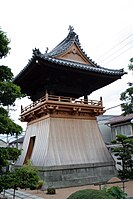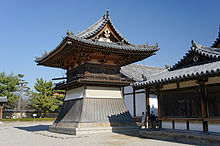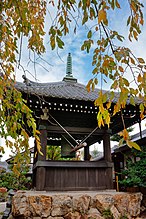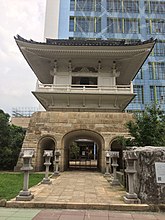Shōrō
The shōrō, shurō (
History
[edit]During the Nara period (710–794), immediately after the arrival of Buddhism in Japan bell towers were 3 x 2 bay, 2 storied buildings.[2] A typical temple garan had normally two, one to the left and one to the right of the kyōzō (or kyō-dō), the sūtra repository. An extant example of this style is Hōryū-ji's Sai-in Shōrō in Nara (see photo in the gallery).
During the following Heian period (794–1185) was developed a new style called hakamagoshi which consisted of a two storied, hourglass-shaped building with the bell hanging from the second story.[2] The earliest extant example is Hōryū-ji's Tō-in Shōrō (see photo in the gallery).
Finally, during the 13th century the fukihanachi type was created at Tōdai-ji by making all structural parts visible. The bell tower in this case usually consists of a 1-ken wide, 1-ken high structure with no walls and having the bell at its center (see photo above).[2] Sometimes the four pillars have an inward inclination called uchikorobi (
Gallery
[edit]- Shōrō
-
Great Bell at Chion-in
-
Goshoji-Temple
-
Hōryū-ji's Sai-in Shōrō, an example of Nara period bell tower
-
Hōryū-ji's Tō-in Shōrō, a typical hakamagoshi type
-
Takidani-hudōmyōō-ji Shōrō
-
Tōdai-ji's bell tower, an example of the fukihanachi type, although much larger than the average
-
Sometimes the bell is installed in the rōmon.
-
shōrō in Taipei, Taiwan.
-
shōrō in Taipei, Taiwan.













